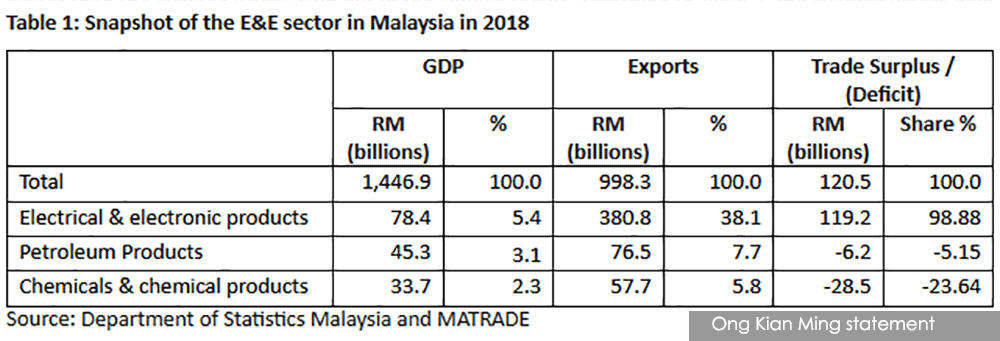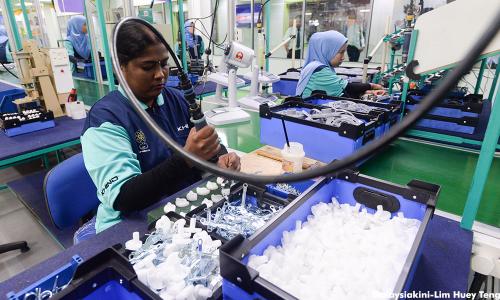Turning point for E&E industry in Malaysia?
MP SPEAKS | The report in June 2019 that Apple was mulling a 15-30 percent supply chain shift out of China and that Southeast Asia was a potential relocation destination created a lot of media interest in Malaysia.
What can the Malaysian government do to pull some of these investments onto our shores? How ready is our local electrical and electronics (E&E) industry to capture part of Apple’s value chain? Which companies could be potential beneficiaries? These questions are part and parcel of a larger debate regarding the E&E sector in Malaysia.
The industry is facing a turning point in its development, and the US-China trade war has created a unique window of opportunity which can catalyse the development of the entire industry in Malaysia for decades to come.

Contribution to the economy
Before we delve into the prospects of the E&E industry, it is important to contextualise the current role which this sector plays in the Malaysian economy. The E&E sector’s contribution to the overall health of the country’s economy goes far beyond its 5.4 percent share of gross domestic product in 2018 (RM78 billion out of a RM1.4 trillion economy).
It is BY FAR, the largest driver of exports in Malaysia. 38.1 percent of the almost RM1 trillion in exports in 2018 came from the E&E sector. Manufactured petroleum products came in at a distant second with 7.7 percent of total exports in 2018.
It is also a disproportionate contributor to the nation’s trade surplus. Out of the RM120.5 billion trade surplus enjoyed by Malaysia in 2018, 99 percent or RM119.2 billion was generated by the E&E sector.
Without the contribution of the E&E sector, Malaysia would have experienced the "twin deficit" phenomenon – a budget, as well as a trade deficit and this, would likely have affected foreign investor confidence.
Many would be surprised to learn that Malaysia’s largest export to China is not palm oil or agriculture or petroleum products but products from the E&E sector. This is also one of the few sectors where Malaysia enjoys a trade surplus vis-à-vis China.

Driver of productivity and wage growth
The E&E sector is also a leader in terms of productivity gains. The E&E sector has been leading the way among the manufacturing subsectors in terms of productivity growth. The average annual growth rate of 10.4 percent from 2011 to 2018 surpasses the productivity growth rate of the petroleum, chemicals and plastics sub-sector as well as the transport equipment subsector (see Table 2).

The E&E and optical subsector is also the largest employer in the manufacturing sector, hiring approximately 562,000 workers of the 2.5 million manufacturing workforce in 2018. The average wages paid out to the E&E sector is one of the highest among the manufacturing subsectors and significantly higher than the average wages paid out in the service sector.
The average wages paid out per employee in the E&E subsector is RM46,451 in 2018 which places it second after the Petroleum, Chemicals and Plastics subsector with average wages paid out at RM52,248 (see Table 3).

One of the main reasons driving productivity and wage growth in the E&E sector is investments in technology and equipment. This sector, more than any other sector in the country, is at the forefront of Industry 4.0 adoption including big data analytics, internet of things (IoT) and systems integration.
Most, if not all, of the companies in this sector, be it multinational companies (MNCs) or local-large companies (LLCs), are exposed to the global supply chain and thus, have no choice but to innovate and invest to remain competitive.
Beyond the numbers
Beyond the figures and statistics displayed above, the development of the E&E sector is at a leading edge of an increasingly complex and sophisticated Malaysian economy.
What used to be a sector dominated by MNCs has shifted to one where LLCs and SMEs play an increasingly important role. Some of the local SMEs which started off being suppliers to the MNCs in Penang have grown into large listed entities which can conduct their own research and development, and venture into new markets abroad. Some of the more well-known names include Vitrox, Inari Amerton, Pentamaster and the recently listed Greatech and TT Vision.
Some of the electronics manufacturing services (EMS) companies in Johor have also grown to be regional players as a result of their business with big MNCs such as Dyson. VS Industry, ATA, SKP Resources and Denko have grown and will continue to grow as part of this supply chain as companies such as Dyson diversifies into other products such as its electric car project which will be based in Singapore but which will source for components from around the region including from Johor-based EMS companies.
As these MNCs have expanded their E&E operations in Malaysia, they have also diversified into services related activities such as regional/global procurement, human resource and accounting administration and IT services for their global operations. This has led to a steady increase in the number of principal hub operations in the manufacturing services sector for these E&E companies. Examples include Smart Modular, Sharp Corporation, Osram, Broadcom (Avago Technologies), and Integrated Device Technology Sdn Bhd.
There is also a small but growing homegrown sector in the higher value-added segments of the E&E sector including R&D activities such as Integrated Circuit (IC) design. Companies such as Infinecs, Experior and Oppstar Technology, which were started by Malaysians who were formerly working for MNCs, are now at a turning point in terms of taking the next leap in their scope and scale of R&D activities.
E&E Productivity Nexus chairperson Wong Siew Hai is absolutely correct in pointing out, in a recent article, that the E&E sector in Malaysia is at a crossroads. Domestically, with the change in government in Malaysia in 2018, and externally, with global uncertainties as a result of the US-China frictions, there are many challenges and perhaps more opportunities for the E&E sector in Malaysia.
However, this requires the government together with the industry partners to work together to capture these opportunities.
ONG KIAN MING is Bangi MP and assistant national director for political education for DAP.
The views expressed here are those of the author/contributor and do not necessarily represent the views of Malaysiakini.
RM12.50 / month
- Unlimited access to award-winning journalism
- Comment and share your opinions on all our articles
- Gift interesting stories to your friends
- Tax deductable
